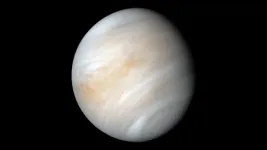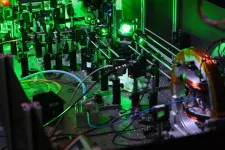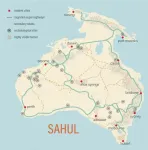(Press-News.org) Venus is an enigma. It's the planet next door and yet reveals little about itself. An opaque blanket of clouds smothers a harsh landscape pelted by acid rain and baked at temperatures that can liquify lead.
Now, new observations from the safety of Earth are lifting the veil on some of Venus' most basic properties. By repeatedly bouncing radar off the planet's surface over the last 15 years, a UCLA-led team has pinned down the precise length of a day on Venus, the tilt of its axis and the size of its core. The findings are published today in the journal Nature Astronomy.
"Venus is our sister planet, and yet these fundamental properties have remained unknown," said Jean-Luc Margot, a UCLA professor of Earth, planetary and space sciences who led the research.
Earth and Venus have a lot in common: Both rocky planets have nearly the same size, mass and density. And yet they evolved along wildly different paths. Fundamentals such as how many hours are in a Venusian day provide critical data for understanding the divergent histories of these neighboring worlds.
Changes in Venus' spin and orientation reveal how mass is spread out within. Knowledge of its internal structure, in turn, fuels insight into the planet's formation, its volcanic history and how time has altered the surface. Plus, without precise data on how the planet moves, any future landing attempts could be off by as much as 30 kilometers.
"Without these measurements," said Margot, "we're essentially flying blind."
The new radar measurements show that an average day on Venus lasts 243.0226 Earth days -- roughly two-thirds of an Earth year. What's more, the rotation rate of Venus is always changing: A value measured at one time will be a bit larger or smaller than a previous value. The team estimated the length of a day from each of the individual measurements, and they observed differences of at least 20 minutes.
"That probably explains why previous estimates didn't agree with one another," Margot said.
Venus' heavy atmosphere is likely to blame for the variation. As it sloshes around the planet, it exchanges a lot of momentum with the solid ground, speeding up and slowing down its rotation. This happens on Earth too, but the exchange adds or subtracts just one millisecond from each day. The effect is much more dramatic on Venus because the atmosphere is roughly 93 times as massive as Earth's, and so it has a lot more momentum to trade.
The UCLA-led team also reports that Venus tips to one side by precisely 2.6392 degrees (Earth is tilted by about 23 degrees), an improvement on the precision of previous estimates by a factor of 10. The repeated radar measurements further revealed the glacial rate at which the orientation of Venus' spin axis changes, much like a spinning child's top. On Earth, this "precession" takes about 26,000 years to cycle around once. Venus needs a little longer: about 29,000 years.
With these exacting measurements of how Venus spins, the team calculated that the planet's core is about 3,500 kilometers across -- quite similar to Earth -- though they cannot yet deduce whether it's liquid or solid.
Venus as a giant disco ball
On 21 separate occasions from 2006 to 2020, Margot and his colleagues aimed radio waves at Venus from the 70-meter-wide Goldstone antenna in California's Mojave Desert. Several minutes later, those radio waves bounced off Venus and came back to Earth. The radio echo was picked up at Goldstone and at the Green Bank Observatory in West Virginia.
"We use Venus as a giant disco ball," said Margot, with the radio dish acting like a flashlight and the planet's landscape like millions of tiny reflectors. "We illuminate it with an extremely powerful flashlight -- about 100,000 times brighter than your typical flashlight. And if we track the reflections from the disco ball, we can infer properties about the spin [state]."
The complex reflections erratically brighten and dim the return signal, which sweeps across Earth. The Goldstone antenna sees the echo first, then Green Bank sees it roughly 20 seconds later. The exact delay between receipt at the two facilities provides a snapshot of how quickly Venus is spinning, while the particular window of time in which the echoes are most similar reveals the planet's tilt.
The observations required exquisite timing to ensure that Venus and Earth were properly positioned. And both observatories had to be working perfectly -- which wasn't always the case. "We found that it's actually challenging to get everything to work just right in a 30-second period," Margot said. "Most of the time, we get some data. But it's unusual that we get all the data that we're hoping to get."
Despite the challenges, the team is forging ahead and has turned its sights on Jupiter's moons Europa and Ganymede. Many researchers strongly suspect that Europa, in particular, hides a liquid water ocean beneath a thick shell of ice. Ground-based radar measurements could fortify the case for an ocean and reveal the thickness of the ice shell.
And the team will continue bouncing radar off of Venus. With each radio echo, the veil over Venus lifts a little bit more, bringing our sister planet into ever sharper view.
INFORMATION:
This research was supported by NASA, the Jet Propulsion Laboratory and the National Science Foundation.
Other researchers who contributed to the study are Donald Campbell of Cornell University; Jon Giorgini, Joseph Jao and Lawrence Snedeker of the Jet Propulsion Laboratory; and Frank Ghigo and Amber Bonsall of the National Radio Astronomy Observatory in West Virginia.
Immunotherapies that fight cancer have been a life-saving advancement for many patients, but the approach only works on a few types of malignancies, leaving few treatment options for most cancer patients with solid tumors. Now, in two related papers published April 28, 2021 in Science Translational Medicine, researchers at UCSF have demonstrated how to engineer smart immune cells that are effective against solid tumors, opening the door to treating a variety of cancers that have long been untouchable with immunotherapies.
By "programming" basic computational abilities into immune cells that are designed to attack cancer, the researchers have overcome a number of major hurdles that have kept these strategies ...
The decision to donate to a charity is often driven by emotion rather than by calculated assessments based on how to make the biggest impact. In a review article published on April 29 in the journal Trends in Cognitive Sciences, researchers look at what they call "the psychology of (in)effective altruism" and how people can be encouraged to direct their charitable contributions in ways that allow them to get more bang for the buck--and help them to have a larger influence.
"In the past, most behavioral science research that's looked at charitable giving has focused on quantity and how people might be motivated to give more money to charity, or to give at all," says first author Lucius Caviola (@LuciusCaviola), a postdoctoral researcher in the Department of Psychology at Harvard University. ...
Scientists in China have developed a small, flexible device that can convert heat emitted from human skin to electrical power. In their research, presented April 29 in the journal Cell Reports Physical Science, the team showed that the device could power an LED light in real time when worn on a wristband. The findings suggest that body temperature could someday power wearable electronics such as fitness trackers.
The device is a thermoelectric generator (TEG) that uses temperature gradients to generate power. In this design, researchers use the difference between the warmer body temperature and the relatively cooler ambient environment to generate power.
"This is a field with great potential," says corresponding author Qian Zhang of Harbin ...
It may seem like an unusual place to go looking for answers, but the contents of a baby's first diaper can reveal a lot about a newborn's future health.
In a new study published today in Cell Reports Medicine, a team of University of British Columbia (UBC) researchers has shown that the composition of a baby's first poop--a thick, dark green substance known as meconium--is associated with whether or not a child will develop allergies within their first year of life.
"Our analysis revealed that newborns who developed allergic sensitization by one year of age had significantly less 'rich' meconium at birth, compared to those who didn't develop allergic sensitization," says the study's senior co-author Dr. Brett Finlay, a professor at the Michael Smith ...
Although robotic devices are used in everything from assembly lines to medicine, engineers have a hard time accounting for the friction that occurs when those robots grip objects - particularly in wet environments. Researchers have now discovered a new law of physics that accounts for this type of friction, which should advance a wide range of robotic technologies.
"Our work here opens the door to creating more reliable and functional haptic and robotic devices in applications such as telesurgery and manufacturing," says Lilian Hsiao, an assistant professor of chemical and biomolecular engineering at North Carolina State University and corresponding author of a paper on the work.
At ...
The best path across the desert is rarely the straightest. For the first human inhabitants of Sahul -- the super-continent that underlies modern Australia and New Guinea -- camping at the next spring, stream, or rock shelter allowed them to thrive for hundreds of generations. Those who successfully traversed the landmarks made their way across the continent, spreading from their landfall in the Northwest across the continent, making their way to all corners of Australia and New Guinea.
By simulating the physiology and decisions of early way-finders, an international team* of archaeologists, geographers, ecologists, and computer scientists has mapped the probable "superhighways" that led ...
BOSTON - Concerns about fertility often influence how young women with breast cancer approach treatment decisions and are a reason for forgoing or delaying hormone-blocking therapy, a new study by Dana-Farber Cancer Institute investigators shows.
The findings, published online today by the journal Cancer, reinforce the need for physicians to talk with patients about their fertility-related priorities and address them in treatment plans, the study authors write. Such conversations are important not only at the start of treatment but during its entire course, as patients' goals ...
Scientists from the University of Bristol's Quantum Engineering Technology Labs (QETLabs) have developed an algorithm that provides valuable insights into the physics underlying quantum systems - paving the way for significant advances in quantum computation and sensing, and potentially turning a new page in scientific investigation.
In physics, systems of particles and their evolution are described by mathematical models, requiring the successful interplay of theoretical arguments and experimental verification. Even more complex is the description of systems of particles interacting with each other at the quantum mechanical level, which is often done using a Hamiltonian model. The process of formulating Hamiltonian models from observations is made even harder by the nature ...
'Superhighways' used by a population of up to 6.5 million Indigenous Australians to navigate the continent tens of thousands of years ago have been revealed by new research using sophisticated modelling of past people and landscapes.
The new insights into how people not only survived, but thrived, in harsh environments provide further evidence of the capacity and resilience of the ancestors of Indigenous people, and help paint a picture of large, well-organised groups navigating tough terrain.
The 'peopling' of Sahul -- the combined mega continent that joined Australia with New Guinea when ...
There was a hope that as more plants start to grow in Arctic and boreal latitudes as our warming climate makes those regions more hospitable for plants, those photosynthesizing plants would work to help sequester the atmospheric carbon dioxide that helped them flourish in the first place. But new research led by scientists at UC Irvine and Boston University, out in Nature Climate Change, suggests that all the new green biomass is not as large a carbon sink as scientists had hoped.
"What does greening really mean? Can we really trust it to save us from climate change?" said Jon Wang, an Earth system scientist at UCI who the led the work alongside BU Earth & Environment professor Mark Friedl. "A big question is: What'll happen to the carbon that's currently ...




